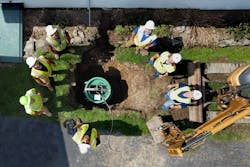Lake Carey Sanitary Sewer Collection & Treatment System Project
Cost: $5.6 million
Location: Lake Carey, Pennsylvania
Year: 2021-12-21
Size: 268 gpm peak flow for low pressure sewer
Owner: Lemon Township & Tunkhannock Township Joint Municipal Sewer Authority
Designers: Larson Design Group
Contractor: Harger Utility Contractors Inc.,
Distribution Partner: Semper Fi Sales
In 2015, the Lemon Township and Tunkhannock Township Joint Municipal Sewer Authority in Lake Carey, Pennsylvania, began the design and bid process for a proposed new Lake Carey sanitary sewer collection and treatment system.
The project was projected to be multi-year and massive, funded in part from a more than $13 million loan from the Pennsylvania Infrastructure Investment Authority (PennVest) and designed to serve 390 residents.
The growing lakeside community had been experiencing failing septic systems, but the topography of the township was not conducive to a regular sewer system. As such, an alternative sewer design was sought, and a low-pressure sewer became the top contender. Paramount was meeting project goals without disrupting the community.
“Lake communities like this often fall into complications with their sewer and their septic treatment because of old infrastructure, like holding tanks and leach fields for home septic,” said Matt Crawford, project manager for Harger Utilities Contractors Inc. “Overtime they are past their service life and can cause issues, especially in lake communities, where they can contaminate water and cause all sorts of problems that Pennsylvania Department of Environmental Protection (DEP) does not like.”
The sewer system is located near a 182-acre recreational lake and served to move residential and commercial waste uphill and out of the natural bowl that the lake created. The Franklin Electric FPS PowerSewer System, a low-pressure sewage collection system, was quickly considered.
The Franklin Electric team performed a hydraulic analysis of the area, which included calculations across 47 zones, and helped prove how the system would perform given the challenging location and topography.
With the hydraulic analysis completed, the team worked closely with the design and engineering group to complete all of the backend design and layout for the system, including all of the piping runs and sizes, capacity requirements, placement of high head versus standard pumping systems, and more. The system provided the minimum 90 gallons of working volume required, calculated from the collection tank bottom to the inlet invert.
The Pennsylvania DEP mandated an Act 537 plan around the lake, which addresses existing sewage disposal needs, and prevention of future problems through the proper planning, permitting, and design of all types of sewage facilities. This plan was approved in 2015 and updated the following year.
With 8.5 linear miles of total pipe needed and the longest segment running over 4 miles, friction losses were a concern. The benefits of low pressure were integral to overcoming this challenge because the system would not need lift stations and the lines could be installed closer to the flow of the terrain. Once these lines went over a certain high point, the anti-siphon check valve would overcome siphoning conditions going downhill on the backstretch.
Project Year: 2021-12-21Contractor: Harger Utility Contractors Inc., Distribution Partner: Semper Fi SalesDesigners: Larson Design GroupOwner: Lemon Township & Tunkhannock Township Joint Municipal Sewer AuthorityLocation: Lake Carey, PennsylvaniaCost: $5.6 millionSize: 268 gpm peak flow for low pressure sewer